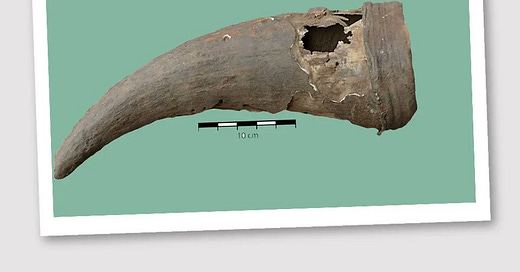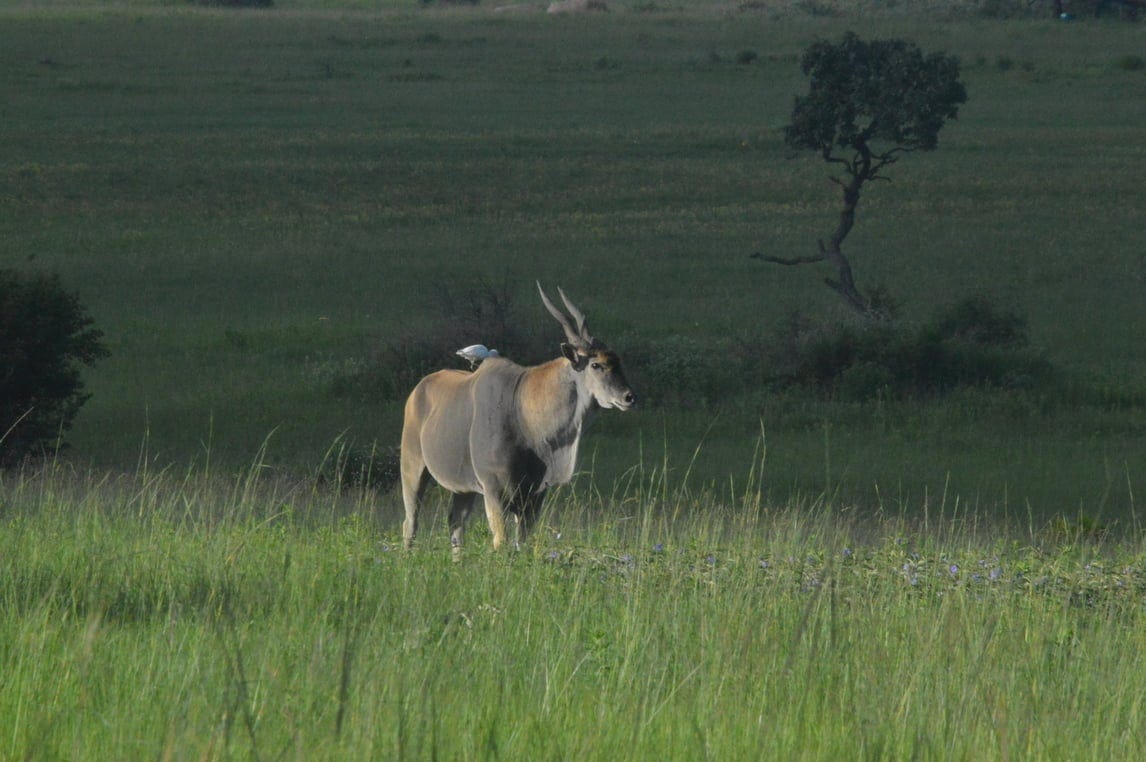Medicine horn unearthed | Imperilled picathartes | Plastic harming seals | Waterberry trees
Ancient medicine horn reveals plants used by SA healers 500 years ago
A medicine horn unearthed in a cave in South Africa’s Eastern Cape province has shed light on the herbal remedies used by indigenous healers more than 500 years ago.
The horn was found bundled up in the long leathery leaves of a veld fan, a plant whose leaves have been used for millennia to preserve organic material. The original owner of the horn evidently planned to come back for it, but never did, say the authors of a study published in the South African Journal of Science.
Chemical analysis of the dried contents of the horn found various compounds consistent with those known to treat fevers and infections: mono-methyl inositol and lupeol. These are found in locally-occurring plants, among them the Namaqua rock fig, the cancer bush and the butterfly pea.
The cave where the horn was found, near the village of Misgund, was adorned with ancient rock art. It’s unclear whether the paintings and the horn were of the same period.
Radiocarbon dating of a sample of the horn places it in use anywhere between 1461–1630.
Its owner could have been from the Khoi, a pastoral community, or the San, who were hunter-gatherers.
Both San and Khoi believed in a mythical water bull, “whose horns were considered to have medicinal attributes,” says the study.


Picathartes nesting site under threat from logging in Ghanaian forest reserve
The white-necked rockfowl – also known as the picathartes – is considered to be one of the most endangered birds in Africa. It is also one of the most striking.
It has a bald yellow head with black patches that make it look as if it's wearing headphones; a snow-white breast, and glossy black wings and back.
The birds mould their cup-shaped nests from clay on the sides of rock faces within closed-canopy forest.
One of the countries where it lives is Ghana, though its range in the West African country has, according to conservation group A Rocha Ghana, diminished severely due to habitat loss to just one last stronghold. This is in the Nyamebe Bepo Forest Reserve, in the southern Ashanti Region.
Now, even that stronghold is under threat. A Rocha warns that logging permits are being approved by the government for the same area where the nesting colonies exist.
“Our checks show that this site has recently been converted from protection to production status, signaling the risk their habitat faces,” it said in a statement.
“There is no doubt that conversion of their habitats into logging concessions will severely threaten the existence of this beautiful bird in Ghana, and undermine any potential benefits they may bring, such as the huge potential for wildlife tourism.”
The group notes that the proposed logging is in breach of local laws that declare the picathartes to be “absolutely protected”, as well as Ghana’s international commitments to protect nature under the Global Biodiversity Framework.
The International Union for Conservation of Nature says there may be as few as 2,500 mature picathartes left across their range, which also extends through Guinea, Sierra Leone, Liberia and Ivory Coast.


Even in a remote Namibian park, plastic pollution is severely wounding seals
In Namibia, conservationists have discovered that human rubbish is affecting Cape fur seals in a remote national park in the north of the country.
The discovery was made by members of Ocean Conservation Namibia (OCN), a local non-profit that works to free seals entangled in fishing nets, plastic and other discarded human waste.
Members sprint along the beach to catch the affected seals with large nets before the animals can lumber off the beach (with surprising speed) back into the sea.
OCN usually operates at two seal colonies near the coastal city of Walvis Bay, but last month it ventured 600 kilometers north, to Terrace Bay in the Skeleton Coast National Park. The park is famed for its small population of desert-adapted lions.
Given its remoteness, the rescue team expected plastic pollution in Terrace Bay to be minimal. They were in for a horrid surprise. They rescued seals with some of the worst entanglement wounds they had ever seen, OCN said in a statement.
Out of 14 seals caught, 10 were so severely wounded OCN decided not to share the video footage of their rescue. Fishing lines, rope, plastic bags and clothing were to blame for the wounds seen and treated.
“It was incredibly disheartening to see what we already knew: there is no escape for marine animals. No safe space. No hidden paradise.”


Nature Notes: The long and short of a notable woodland tree
In my diary, February in Zimbabwe is notable for the fruiting of the woodland waterberry, a species of tree that grows throughout southern Africa.
Its burgundy berries are a magnet for birds.
As I watch the likes of turacos, bulbuls and barbets foraging high up in the crown, I marvel that a species of tree this size can adapt to growing underground.
I’m talking here of the dwarf waterberry — an underground form of the woodland waterberry that grows barely higher than my ankles.
I first came across these ‘underground trees’ on a visit to Harare’s Haka Park one October, at the height of the dry season.
They formed eye-catching green patches against the baked yellow ground and were flowering with the same ‘shaving-brush’ blossoms typical of the bigger tree.
Scientists say these underground, or suffrutex forms of common woodland species, are an adaptation to an array of environmental pressures, like fire or frost.
In the absence of these “environmental stressors” they can grow out of their diminutive state.
An eland at Haka Park, a nature reserve and wetland where both ‘long and short’ forms of the woodland waterberry tree grow | Pic: Ryan Truscott




